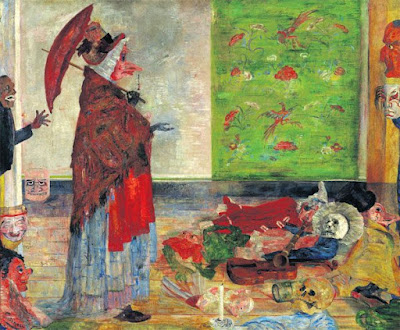At the Brussels exhibtion I found it fascinating to plot the history of this artist who thrived in stylistic and thematic variety and who first produced work best described as realist, but who gradually turned towards the imaginary and fantastic, with grotesque, masked figures and uncanny apparitions.
 |
| Photo: Danny de Vries |
 |
| Photo: Danny de Vries |
In the above painting, "The Intrigue" (1890) we see a couple in the centre. The bride clutches the artist (Ensor lived a long life, but never married,) while Death is entering the picture from the upper right. The woman in the lower right corner has a Japonesque doll or baby thrown over her shoulder, like a little corpse. In this painting, as in many of Ensor's works from the lates 1880s onward, the figures are wearing masks, or have faces that look like masks.
Here is another of his strange pictures, "The Astonishment of the Mask Wouse" (1889):
The old woman stands before a pile of costumes and masks that have been discarded on the floor. The objects seem to have entered from a dream or nightmare. The panel on the back wall reflects a beautiful palette. Who are the strange masked figues enetering the scene from the sides? Is the grotesque woman supposed to remind me of Whistler's mother? Is this a scene from the celebration of Carneval, or the Danse Macabre? Ensor's art is leaves one with questions.
A lot more information about Ensor and interpretations of his work are provided by the James Ensor Online Museum.


No comments:
Post a Comment